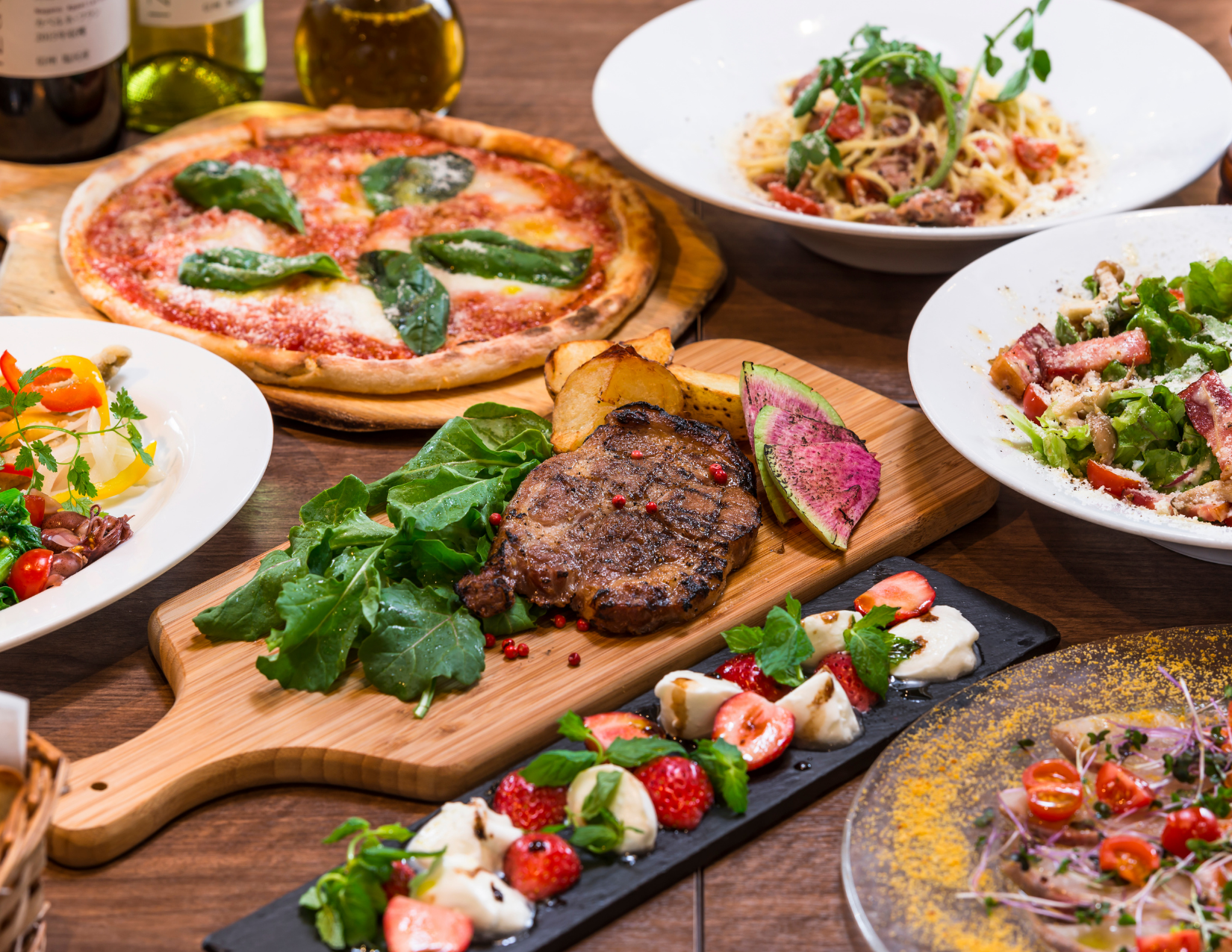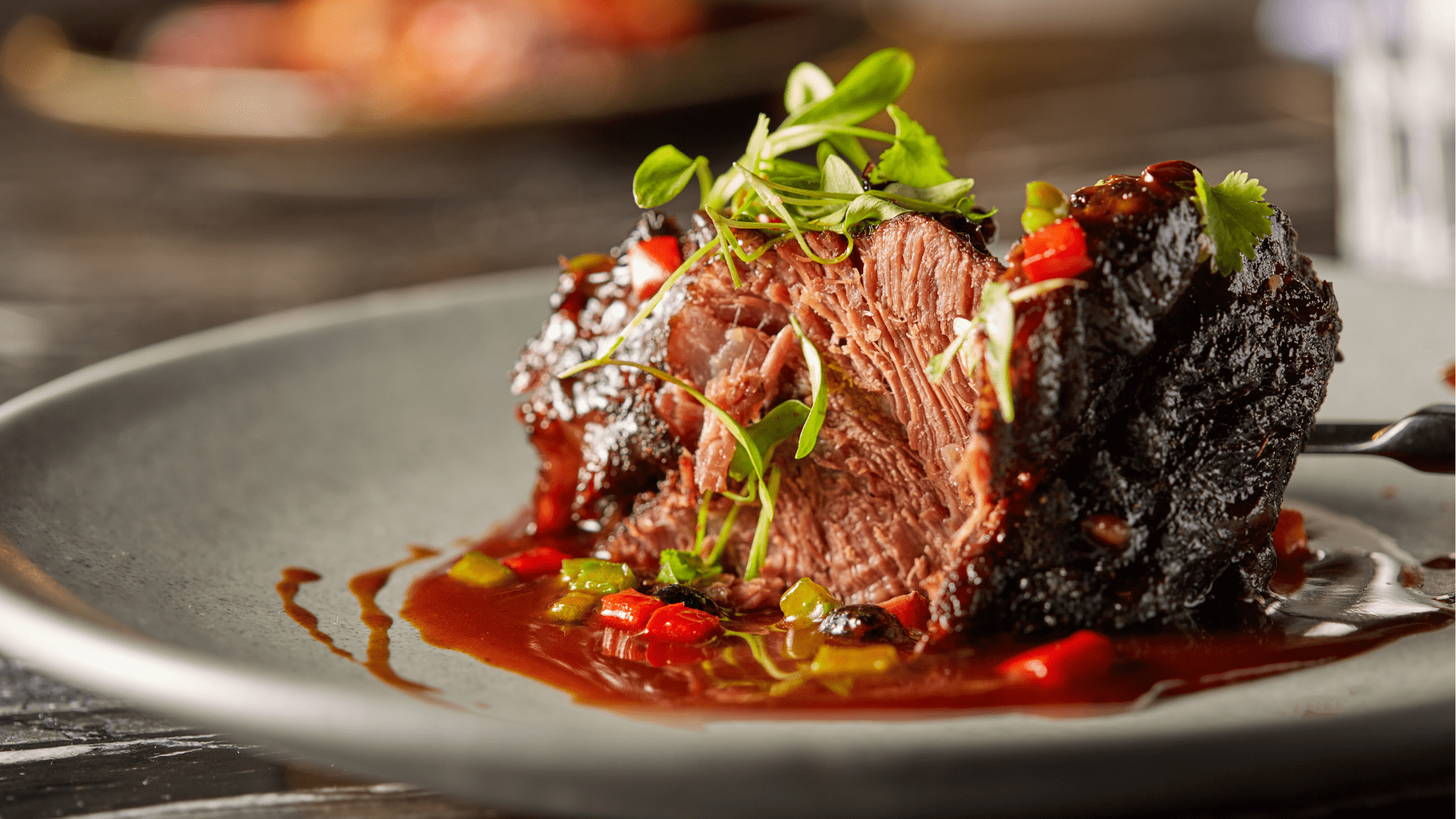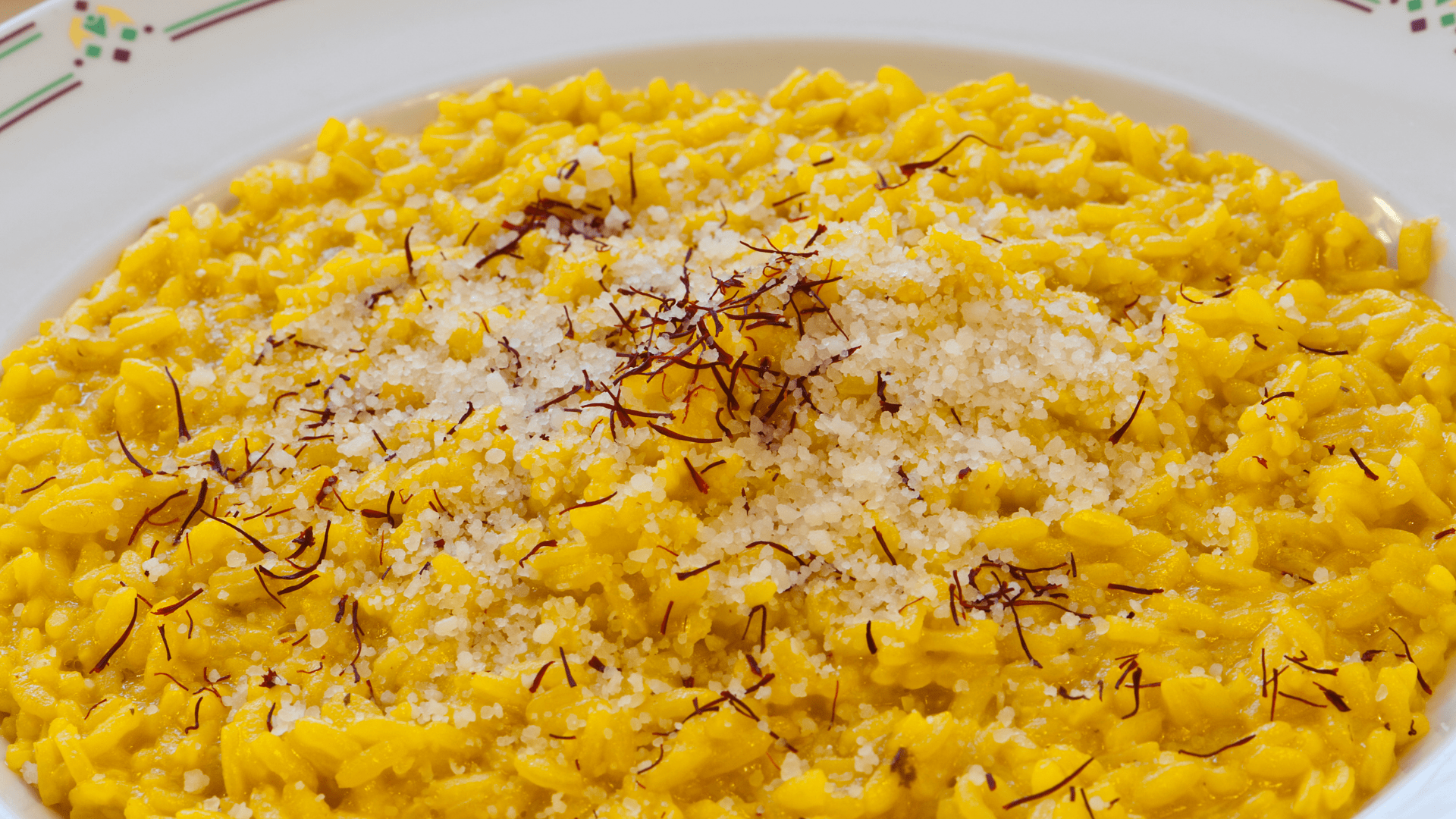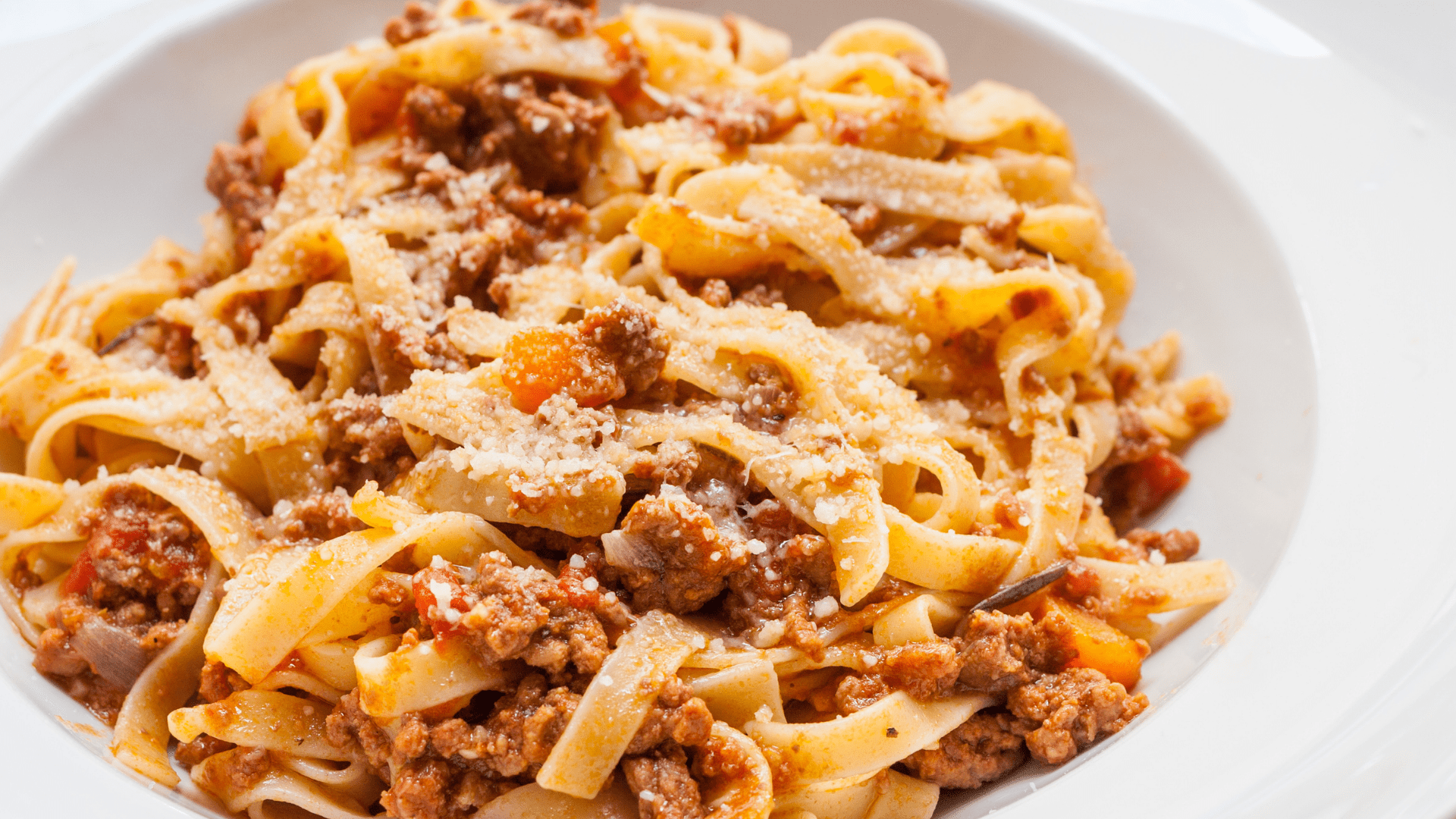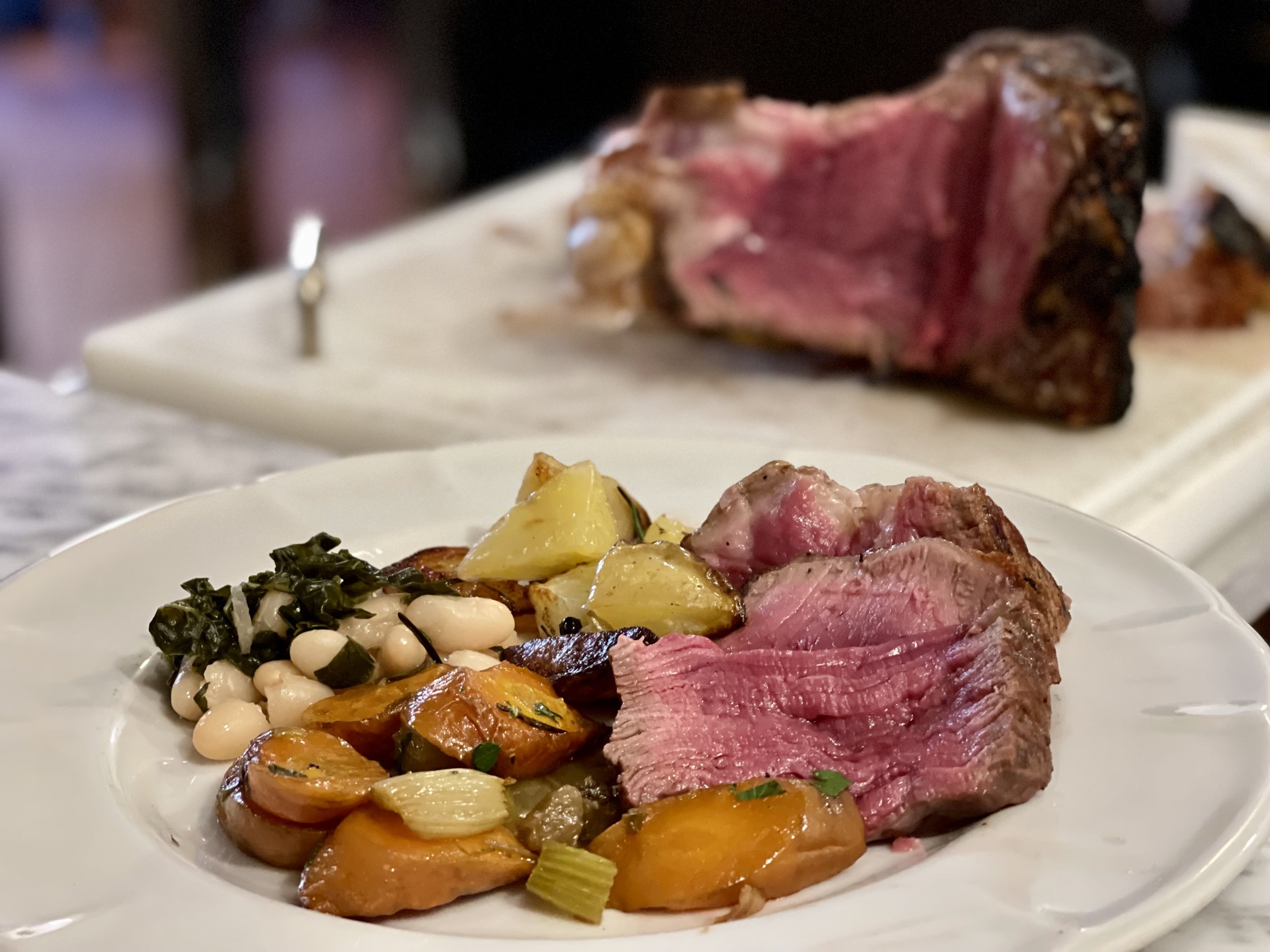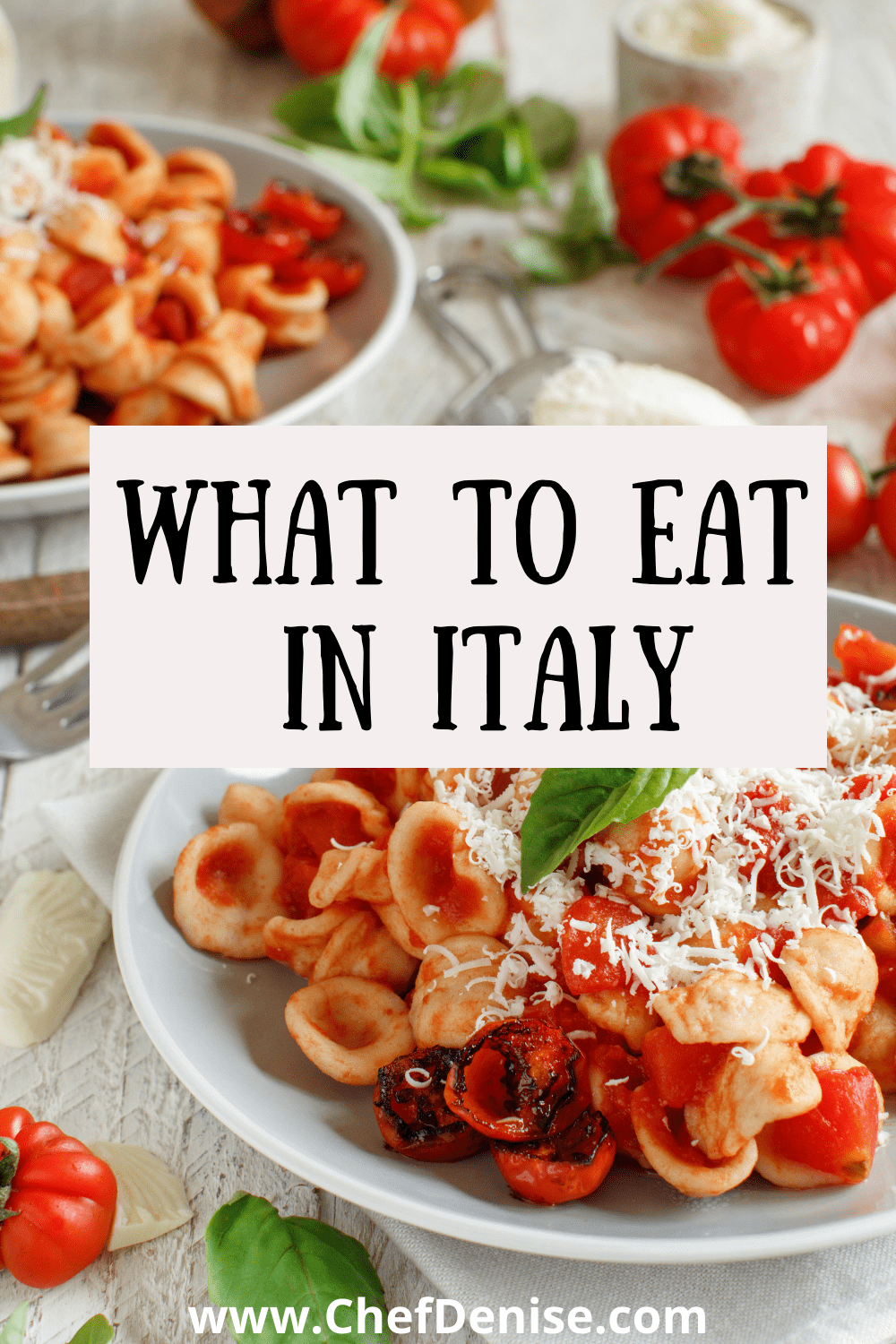Ultimate Guide to Italian Cuisine: Food in Italy
Regional dishes of Italian cuisine
Although there’s lots to see and do in the land of my forefathers, eating traditional Italian food is my favorite activity when visiting Italy! Classic Italian cuisine has such a wide variety of authentic dishes, and much more than pizza and pasta with marinara sauce (although these are amazing). I have been lucky enough to visit Italy many times, and each trip has been a quest to find the best food in Italy.
With more than a few 4-hour Italian meals under my belt, I certainly feel like I’ve done my fair share of hands-on research on the food of Italy to answer the question, “What should I eat in Italy?” And even with the abundance of delicious food in Italy that awaits, “everything” is not the answer. The real answer is that it depends: Italian food varies by region, so what to eat in Italy will depend on where you are in Italy! And that’s what this Italy food guide is all about. You’ll not only discover which delicious foods to eat in Italy but where to eat them.
Italian Cuisine & Food Culture
Food in Italy begins at the ingredient level of the region. Italians invented the Slow Food movement, which centers on using locally sourced ingredients to prepare regional Italian dishes. The diverse terrain and geography of Italy almost makes natural dividers for crops and access to particular ingredients. As a result, what makes it into any Italian kitchen varies from place to place, meaning what ends up on the table will vary as well.
The traditional Italian recipes by region are influenced by the local soil and weather conditions and the specific effects of the nearby mountains, sea, valleys, and neighboring countries. The focus on the local is at the core of Italian cuisine and the varying Italian food cultures found throughout the country.
I love strolling down the streets in any Italian city or village and peeking in the markets to discover the delicious local cheeses, pasta, meats, and Italian specialty foods because they are different in every region! Indeed, there is no one staple food of Italy common to everywhere. The staple foods of Italy are really the combination of staple foods from all the different regions. Italian cuisine is really the sum of local Italian cuisines from throughout the country. Italy food culture wouldn’t have it any other way. The history of Italian cuisine shows us that it has always been so.
Most of my favorite travel memories of Italy center around food (not surprising since my life literally revolves around food). I’ve had incredible Italian food experiences, from picnicking on the side of the road in Umbria to feasting at Michelin-starred restaurants. And I’ve even been chased down in the parking lot by one of the starred chefs so that he could give me a kiss on the cheek and a gift of homemade pasta after a visit to his restaurant.
One thing I’ve learned is that the key to finding the best food in Italy is to embrace the Italian food culture of regionality. In other words, eat the traditional dishes and ingredients of the region of Italy you are in!
What To Eat In Italy: The Best Regional Dishes from North to South
To answer the real question of what to eat in Italy and where, I’ve asked chefs, travel bloggers, and food writers to weigh in with their recommendations, and, of course, I’ve included a few recommendations of my own. If you see something mentioned by more than one of our experts, then you REALLY should not leave Italy without eating that dish!!! Here is our list of the best regional Italian foods and where to eat them!
Northern Italian Cuisine
Brasato al Barolo
Recommended by Denise from Chef Denise
You will come across the main dish Brasato al Barolo (beef braised in Barolo wine) throughout northern Italy, however, Piedmont is the definitive region in which to order it. Piedmont produces the two signature ingredients of the regional dish: Barolo wine and Piedmontese beef.
In Italian cuisine, even the type of beef can matter! Not all beef is the same! The local breed of cattle, Razza Bovina Piemontese, actually has a genetic mutation that makes it different—it grows excessive muscle, so it has less fat and connective tissue than most beef.
To make this local signature dish, a boneless chuck roast from this prized cattle is marinated (24 hours) and braised in one of Italy’s best red wines, Barolo. Simmering the meat for hours makes the meat so tender, it literally falls apart and just about melts in your mouth!
Italians love to cook with wine, and because of the braising, this dish uses a lot of it. Of course, braising is not unique to Italian cooking; it has been around for hundreds of years. It’s the exceptional local ingredients that make this dish an Italian specialty.
This region has some of the best wine for cooking and drinking! In addition to Barolo, try some Barbaresco, Nebbiolo, and Barbera while you’re in the area. Cheers!
Rosa di Gorizia
Recommended by Larch from The Silver Nomad
The Rosa di Gorizia, or Rose of Gorizia, is not actually an Italian type of rose, but the vegetable known as radicchio.
In the town of Gorizia in the northeast of Italy, they cultivate radicchio a unique way that creates the beautiful, loose rose form instead of the usual tight ball of leaves.
The Rosa di Gorizia is started off as normal, with the sowing of their seeds in the fields from spring to late summer.
Around October to November, the plants are collected and moved to the old air raid shelters left over from the Second World War to mature and ripen into winter.
In January or February, the outer leaves are removed to reveal the rose-like hearts, and the Rosa di Gorizia are harvested.
The Rosa di Gorizia has a crunchy texture with a slightly bitter taste, and is highly prized in Gorizia and throughout the Friuli Venezia Giulia region. The color can vary from a deep red to pinkish or magenta with variegated shades.
Delicious on its own with a touch of olive oil or balsamic vinegar, or used in salads, this unique radicchio brings some freshness to winter food. It is also available made into creams and pastes, or used to fill pasta or chocolates. Wash it all down with some Grappa Rosa di Gorizia!
Risotto
Recommended by Denise from Chef Denise
Arabs brought rice to the north of Italy during the Middle Ages, and the regions of Piedmont, Lombardy, and Veneto turned out to provide the perfect growing conditions for the short-grained rice, Arborio, used to make risottos. In fact, in the north of the country, risotto is even more popular than pasta!
Although it is a rice, risotto is most often served as a primi before the main course, and the preparation of risotto is completely different from the preparation of most other rices. It is slowly cooked by adding broth a little at a time until it becomes deliciously creamy.
You will find many versions throughout northern Italy, but these are my top 3 regional risottos.
Risotto alla Milanese in Lombardy
This classic creamy rice dish is the most famous of the risotto family. Legend has it that in 1574, at the wedding of their master’s daughter, glass workers of Milan’s Duomo added saffron to the rice. This was a method for coloring glass, and it was intended as a joke. The joke was on them because the rice was a big hit!
Today, the delicious recipe for Milanese Risotto with beef broth, beef bone marrow, butter, onion, and Parmesan cheese has changed little.
In addition to this dish being served as a primi, you may see it as a side to another specialty of the area, Ossobuco. This combination is one of my favorite meals; order it if you can!
Read Next: Where To eat in Milan
Risotto ai Funghi in Piedmont
As the name suggests, Risotto ai Fungi is mushroom risotto. If this sounds boring to you, you may not realize what kind of mushrooms are found in in this region. In addition to a wide variety of wild mushrooms, the most coveted of all Italian mushrooms, the porcini, is king here.
I hate picking favorites, but this is my favorite risotto, especially if you’re lucky enough to find one with shaved truffles! Piedmont, and more specifically Alba, is the truffle capital of the world. If you’re here, you must try them!
Risotto al Nero di Frutti di Mare in Veneto
Because the Veneto region is rich in produce, you will see many vegetarian versions of risotto here, including those that spotlight such vegetables as asparagus, peas, and one of the region’s favorites, radicchio. However, the Seafood Risotto with Squid Ink is definitely more unique and special, especially in and around Venice.
In addition to seeking out regional specialties, I like to order things I wouldn’t typically make, and this is one of them. It is not the most beautiful dish, but if you’re a seafood lover, you’ll look past its looks and be happy you did!
Polenta
Recommended by Or from My Path in the World
Polenta is a dish you'll find in various countries, including Romania, Slovenia, and Switzerland, but it originated in northern Italy and has historical roots that go all the way back to Ancient Rome. It is made of cooked cornmeal and is served as porridge. Sometimes it's cooled down, and when it becomes solid, it can be baked or fried. It is also served as a side dish and can be enriched with cheese and butter.
Before Europe even knew what corn was, it was common practice to make polenta from other starchy ingredients like farro (a popular Italian cereal), millet, rye, spelt, chestnut flour, or chickpeas. Today, polenta is pure comfort food, but in the past, it was the food of the poor, or as they call it in Italy—La Cucina Povera.
To this day, polenta is one of the most popular dishes in northern Italy (and even considered more popular than bread and pasta), and you can easily find it in most restaurants across Italy's north. Fun fact: Taking place throughout the year in various places in Italy, polenta has more than ten festivals dedicated to it!
So if you're in for a delicious, hearty dish and are going on a trip to northern Italy, you must add polenta to your foodie bucket list!
Cuisine of Emilia-Romagna
Salumi
Recommended by Denise from Chef Denise
Emilia-Romagna is often described as the foodie capital of Italy and the epicenter of Italian cuisine. The cities of Modena, Parma, and Bologna are each culinary destinations in their own right, with Bologna being the capital of the region.
The world’s most outstanding balsamic vinegars hail from Modena, Italy, the best Parmigiano Reggiano and prosciutto from Parma, and Bologna’s famous foods include its ragù, mortadella, and stuffed pastas. Every Italian food lover should visit Bologna and relish eating some of the best food from Bologna in one of Italy’s less-visited jewels!
Prosciutto and mortadella fall under the umbrella of salumi, or cured meats, which is not to be confused with salami. All salamis are salumi, but not all salumi is salami!
You may think you know salami, but there are over 300 kinds in Italy that vary in size, shape, texture, and flavor, so taste something new! Other popular salumi choices include speck, soppressata, coppa, and bresaola. If you’re not afraid of a little heat, try nduja, a unique spicy pork spread delicious on crunchy Italian bread.
The most coveted cured hams, culatello di Zibello, rarely leave Italy. If you have the opportunity to try these cuts in Italy, you must! If you are near Parma, visit the Culatello Museum at the Antica Corte Pallavicini, and do a culatello tasting there after your tour.
Salumi and cheese boards are available at restaurants throughout the region. Or, you can pack up a picnic lunch with your own ingredients and be sure to include some local flatbread, Parmigiano Reggiano, and balsamic vinegar.
Ragù alla Bolognese
Recommended by Denise from Chef Denise
It may come as a surprise that Italy’s most famous sauce, Ragù alla Bolognese, never comes with spaghetti in Italy! Instead, it is most often served over fresh tagliatelle to make Bologna’s signature dish Tagliatelle alla Bolognese, which is usually topped with grated Parmigiano Reggiano cheese.
You may find Ragù alla Bolognese served with other wide pasta noodles like fettucine and pappardelle (yes, please!), and it is the sauce most often used to make lasagna.
While the first written recipe for Ragù alla Bolognese in Italian cuisine history dates back to 1891, the most authentic recipe is considered to be the one approved by the Italian Academy of Cuisine in October 1982. Traditionally, this meat sauce combines beef and pork with tomato puree, dry wine, milk, carrot, celery, onion, salt, and pepper. Today, you will find many variations by not only Bolognese chefs, but chefs around the world.
One thing can be agreed upon, and that’s if you are visiting Bologna, you must try this traditional Italian dish in its birthplace!
LiguriaN Cuisine
Trofie al Pesto
Recommended by Denise from Chef Denise
Trofie al Pesto is the quintessential dish of Liguria. It combines two delicious regional ingredients, Trofie pasta and Genovese Pesto, into one incredible dish that is a must try if you are ever in this region. And don’t be afraid to try it in multiple restaurants! If you’re like me, you will definitely need this dish more than once!
Made with just durum wheat flour and water, Trofie dates back to the Crusades. Traditionally, tiny pieces of dough are hand-rolled and then twisted to make this unique pasta shape.
In Liguria, this regional pasta is usually served as a first course with the Number 1 regional sauce, Genovese Pesto. Although pesto is a simple uncooked sauce to make, it is complex in flavor. And authentic pestos will be made with the freshest and finest ingredients.
The ingredients are pounded into a paste of fresh basil, Ligurian extra virgin olive oil, high-quality garlic, pine nuts, and the best cheeses, such as Parmigiano Reggiano DOP, and/or Pecorino cheese from Rome, Tuscany, Sardegna, or Sicily.
Although pesto sauce originated in Genoa, you can find this tasty sauce throughout the Ligurian region. You may see it with other types and shapes of pasta, and it will still be delicious, but for a truly authentic Italian food experience, try the Trofie al Pesto.
It may be the wonderful scenery of Liguria biasing my taste buds, but I think Trofie al Pesto truly does not taste the same anywhere else!
Tuscan Cuisine
Pappa al Pomodoro
Recommended by Wendy from The Nomadic Vegan
If you're a fan of Italian cuisine, you probably already know that "pomodoro" means "tomato." As for "pappa," we're not talking about the Pope or about anyone's father (that would be "papa" and "papà," respectively). The word "pappa" with two "p"s refers to a type of porridge, or really any kind of food with a mushy consistency.
In this case, it's a tomato soup that's made with day-old bread. Rather than waste the stale, crusty bread, thrifty Tuscans instead rub it with garlic and then let it soften in tomato sauce until it turns into mush. This is a classic "cucina povera" dish in traditional Tuscan cuisine. Many such recipes have evolved over a long time and involve rather ingenious ways of reusing leftovers and other ingredients that would otherwise be thrown away.
Nowadays, it's not just the poorer classes who eat "cucina povera." It's become rather trendy in recent years, and you're likely to find Pappa al Pomodoro on menus throughout Tuscany, from the best restaurants of Lucca to the finest eateries in Florence.
In fact, one of my favorite places to eat it is Trattoria Enzo e Piero in Florence. Although it's usually served warm in restaurants, Tuscans sometimes also eat it cold. In either case, a good tip is not to dip a slice of bread into your Pappa al Pomodoro. If you do, locals may give you a funny look and tell you that there's plenty of bread in the soup already!
Panzanella
Recommended by Denise from Chef Denise
Panzanella is another Tuscan dish invented as a way to use up old or stale bread. Panzanella was born a poor man’s dish, but don’t let the humble beginnings fool you; it’s rich in flavor! In fact, this bread salad has become one of my favorite salads to both make and eat!
Panzanella first appeared in the 16th century when the Italian painter Bronzino became very fond of onions with oil and vinegar served with toast. This combination developed into a salad with the addition of the leafy vegetable purslane and cucumbers. Tomatoes were added in the 20th century, and are now considered one of the main ingredients.
Because summer is tomato season, Panzanella, like the fresh tomato sauce, Checca, is often associated with that season, and that is when you’ll find the best Panzanella. Ironically, despite the stale bread, this is always such a fresh tasting salad!
Because it was considered a peasant’s meal, this salad was once only served in the home, but now you will find it on menus throughout Tuscany and even in other regions with some slight variations.
Bistecca alla Fiorentina
Recommended by Savannah from The Travelling Barnacle
Bistecca alla Fiorentina, or "Beef Steak in the Florentine Style," is a must try when visiting Florence! This steak was seriously the best I've had in my entire life.
Bistecca alla Fiorentina has been around since the creation of Florence itself. So, if you want to eat like a local in Florence, you must have this most famous of local meat dishes! It can be traced back to the 1500s, to the feast of San Lorenzo, or Saint Lawrence. This is no ordinary steak either. Traditionally, the Bistecca Fiorentina comes from a specific breed of Tuscan cattle, the Chianina (although other breeds are sometimes used). The Chianina are known for producing flavorful, and extremely tender meat.
The Fiorentina is a porterhouse cut of meat and is HUGE—as in meant to feed 2 to 4 people huge, depending on where you go. While the minimum thickness for a porterhouse in the United States is 1.25 inches, the famous Florentine steak is typically 2 to 3 inches thick! Italians actually measure steak by finger width, and a good Bistecca alla Fiorentina should be 3 to 4 fingers high! This is partially why the Bistecca alla Fiorentina is served as a very rare steak.
Apparently, the most important part in getting this steak its amazing flavor is how long the meat is aged for, or how long it’s left hanging before usage. While most meats hang for around 2 days, the Bistecca alla Fiorentina hangs for 15 to 21 days! If you don’t mind a rare steak, the Bistecca alla Fiorentina is a must-try dish while you’re in Florence!
Cuisine of Lazio
Cacio e Pepe (traditional)
Recommended by Pamela from The Directionally Challenged Traveler
While many people don’t think of macaroni and cheese as a traditional Italian dish, it is one of the original recipes from the eternal city of Rome. That is, if it’s the version known as Cacio e Pepe (or cheese and pepper), a simple but elegant dish.
It’s one of the must-eat dishes for foodies visiting Rome!
This delicious spaghetti and cheese recipe is one that never goes out of style. It’s an Italian dish that dates back to the Roman Empire—all the way back to when the Colosseum was built!
Dried pasta, aged pecorino, and black peppers were easy to carry and hard to spoil, making them ideal ingredients for the perfect meal for Roman shepherds. There is no butter, cream, or oil in the recipe. The secret is mixing good quality Pecorino Romano with a few spoonfuls of pasta water to make a thick, creamy, and delicious cheese sauce.
Pair it with an Italian Pinot Grigio white wine for an elegant meal. My kitchen transports me back to Rome whenever I make this dish.
Cacio e Pepe (a new twist)
Recommended by D&J from Make Them All Trips of a Lifetime
For us, Italy is not just a bucket-list destination, it is a second home. With a large family residing in the central regions, I have spent many a summer exploring the sights, sounds, and especially the tastes of Italy. After a long hiatus, a family wedding provided the perfect excuse to return to my roots, introduce my husband to my Italian family, and watch as he tasted all the deliciousness the country has to offer.
On our first night in Rome, we dined with family who introduced us to the traditional dish of Cacio e Pepe pasta. Simple, yet decadent, the creamy Pecorino Romano and pepper sauce is one of Rome’s most ancient recipes, dating back centuries. It became our go-to selection at every Roman restaurant thereafter.
Modern Roman restaurants have adapted the simple flavors of Cacio e Pepe to a multitude of dishes, including pizza, potato croquettes, and even meatballs. We had the pleasure of dining al fresco at the Antica Osteria Rugantino, located in the trendy Trastevere area of Rome. We ordered both the Er Cacio e Pepe (pasta) and Porpette ar Cacio e Pepe (meatballs), with a side of Patate Novelle Arosto (roasted potatoes).
The hand-made pasta was thick, floury, and deliciously coated in the creamy sauce, but the meatballs were absolutely swimming. Presented in a deep bowl, they were large and looked dense, but were incredibly light and soft. The signature creamy sauce took on a slightly different flavor, absorbing the juices from the porpette. When the meatballs (and rustic bread) didn’t sufficiently absorb the provided sauce, I shared my pasta with my husband so that he could devour every last drop.
Cacio e Pepe may be an ancient recipe, but it has evolved and expanded to a wide variety of dishes. When in Rome, do as the Romans do, and indulge!
Spaghetti alla Carbonara
Recommended by Denise from Chef Denise
Although it’s a relatively new dish as far as Italian cuisine goes (1944), I need to include Spaghetti alla Carbonara because it was my absolute favorite thing to eat in Rome. Unfortunately, it’s also one of the most decadent.
To me, the combination of the smoky, salty, cheesy flavors in Spaghetti alla Carbonara are perfect. The typical recipe contains pancetta, hard cheese (usually Pecorino Romano, Parmigiano Reggiano, or a combination of the two), egg, and black pepper. An authentic Carbonara will have a creamy texture without the addition of cream. Some of the creaminess comes from egg. If you receive a raw egg yolk on top, do not be alarmed, just quickly stir it in, and enjoy the YUM!
The first time I went to Italy, I fell in love with Spaghetti alla Carbonara. However, I was a teenager then, and calories didn’t matter. And, of course, when you’re on vacation, they don’t matter either! So, I had two good reasons to eat as much Carbonara as I wanted, and I did!
Years later, when my husband and I were in Rome, I again went on a Spaghetti alla Carbonara eating spree. We often went to a local restaurant for lunch that had 3 things on the menu—I always got the Carbonara, Mike always got his favorite, Spaghetti alla Amatriciana (a red sauce with guanciale), and neither of us ever tried the third item. In full disclosure, if he were writing this, Amatriciana would be on the list instead of Carbonara!
Roman Porchetta
Recommended by Katie from The Plate Unknown
A whole suckling pig, deboned, rolled, stuffed with garlic and fresh herbs and roasted on a spit. If you don’t love everything about that sentence, we can’t be friends.
Nonetheless, the history of porchetta goes back 3,000 years to the Prisci Latin Priests of Ariccia, a town just south of Rome. The priests prepared this pork dish once a year to celebrate the birth of “The Latin League.” During the Roman era, it was served as an offering to the god Mars at the Temple of Jupiter, and it was a favorite of Emperor Nero—yes, THAT Emperor Nero. Traditionally it was cooked in a pit, but by medieval times it was roasted on a spit for 7 to 8 hours until the skin was crunchy.
Nowadays, porchetta is found throughout Italy in two general styles. Umbrian Porchetta is stuffed with fennel and the organs of the pig. Whereas Roman Porchetta has more herbs in the stuffing, and no organs. Outside of Rome you will only really see Porchetta on festival days. In the Eternal City, however, it’s a common Rome street food. Porchetta panini (porchetta sandwiches) can be found sold from holes in the wall, food trucks (porchettari), and restaurants throughout Rome. They makes an ideal snack to grab on the go, with the perfect combination of soft bread, crunchy crackling, and rich juicy meat. Porchetta was also selected by the Italian Ministry of Agriculture as a “traditional agricultural-alimentary product,” attesting to its special cultural significance.
The consensus on the best place to find the choicest porchetta in Rome is Er Burchetto, near the Rome Termini train station. However, porchetta can be found all over Rome. A personal favorite of ours is Cantini dei Papi in Trastevere, which also serves a superb charcuterie board but only has about 5 seats, so it’s best to get a porchetta panino to go.
Porchetta di Ariccia
Recommended by Shelley from Travel-Stained.com
You can eat Porchetta di Ariccia all over Italy, but for a truly authentic experience, do as the Romans do, and head to Ariccia in the Castelli Romani to eat it at its source.
Porchetta is made from a female pig that’s deboned, salted, hand massaged with fragrant herbs, and slow roasted at least 4 to 6 hours. The resulting Porchetta di Ariccia has a crunchy skin and succulent meat. It's often served as filling for a sandwich in local casareccio bread, but you can also eat it solo.
The place to try porchetta is at one of the fraschette that line the Via Borgo S. Rocco in Ariccia. These informal osteria-like restaurants are endemic to the Castelli Romani region, and have a lively, casual atmosphere and long, communal tables. They're named for the fresh “fraschetta” or grape branch that was nailed onto a cellar’s entrance in ancient times to advertise the latest vintage and draw in customers. Once inside, order a vast antipasto centered around Porchetta di Ariccia and wash it all down with some locally produced frizzante wine.
The art of making porchetta is still passed down carefully from generation to generation in Ariccia, as it has been since before Ancient Rome became the empire we know of today. In 2011, the Porchetta of Ariccia was designated as an I.G.P. product, meaning that it has to meet rigid criteria and actually be produced in the town of Ariccia to rightfully be recognized as Porchetta di Ariccia.
Cuisine in Abruzzo
Chitarra e Polpettine
Recommended by Denise of Chef Denise
If you are in Italy and see spaghetti and meatballs on the menu, you are likely in a restaurant that caters to tourists.
While meatballs themselves have roots in Ancient Rome, Italians don’t typically eat the meatballs and pasta together. Usually spaghetti and pastas come as a “primi” before the main course, whereas meatballs would be served as a main course.
However, Chitarra e Polpettine in Abruzzo is often eaten as one course for a Sunday family lunch, and it is probably the closest you will come to the popular Italian-American dish while eating authentically in Italy.
Polpettine are tiny meatballs about the size of marbles. Traditionally prepared with a combination of beef, lamb, and/or pork, they are formed into small balls, fried, and cooked slowly in a red tomato sauce. The polpettine in the sauce is then served on top of chitarra pasta.
Chitarra is an Abruzzese specialty spaghetti made by pushing the pasta dough through the strings of a guitar-like tool called a “chitarra,” which means “guitar.” I personally think the tool looks more like a zither, but I don’t think anyone is going to rename it.
The people of the small village of Valle San Giovanni claim to have been making this regional dish for hundreds of years, and the polpettine here are considered by many to be the best in the world.
Campania Cuisine
Pizza
Recommended by Anda from Travel For a While
The most famous Italian food—pizza! It's the perfect snack or lunch, popular all over the world. However, you will only find authentic pizza in the Campania region in Italy, around Naples, its birthplace. If you can only eat one food in Naples, let it be pizza Napoletana.
In the 18th century, Naples was a rich kingdom, but a lot of poor people lived in its surroundings too. They needed simple but filling food, and many times they combined all they could find for a quick meal. A flatbread topped with tomatoes, cheese, anchovies, and olive oil was easy to throw together and inexpensive at the same time.
When Margherita, Queen of Italy, visited Naples in 1889, the locals prepared for her a pizza topped with the colors of Italy: red tomatoes, white cheese, and fresh green basil leaves. She loved it, and this particular pizza was then named after her, Pizza Margherita.
Later, pizza became famous all over the world, but still, tasting a pizza in the Campania region is a different experience. This thin-crust pizza is wet in the middle and can only be eaten with a fork and knife. So, even as a Naples street food, it’s not sold by the slice, but the whole pie.
Fresh mozzarella cheese and ripe tomato sauce make all the difference in the world. You should also try the Marinara pizza with garlic and the pizza Napoletana with anchovies while you're in the region.
Read Next: Things To Do in Naples, Italy
Caprese Salad
Recommended by Denise of Chef Denise
Pizza may be the most famous food of Campania, but the Caprese Salad (pronounced “cuh-PRAY-zay”) is one of the world’s best loved salads! And it’s also one of the easiest to make.
The key to this simple salad of mozzarella, tomato, and basil is to start with the freshest and highest quality ingredients, all readily available in the region of Campania, where Capri—the island the salad is named after—is situated.
Campania is also home to native water buffalo that are used to make the world famous buffalo mozzarella. To be clear, this is not your average part-skim, American grocery store mozzarella. This is the real deal: fresh, soft, creamy, flavorful mozzarella. And this authentic version of mozzarella makes a world of difference, especially in a dish like Caprese Salad that has only 3 ingredients! Local, delicious mozzarella is also one of the key reasons the pizza in Campania is so good!
Italy grows hundreds of varieties of the second key ingredient, tomatoes, and the most revered are grown in Campania. The sweet-flavored, low-acid, thick-fleshed San Marzano tomatoes from Valle del Sarno are ideal for salads, tomato sauce, and most Italian recipes.
You can purchase them canned, even in the States, for use in making a delicious sauce. Make sure to look for the DOP (Denominazione di Origine Protetta or Protected Designation of Origin) on the label.
In Italian cuisine, nothing complements fresh mozzarella and tomatoes in a Caprese Salad better than the third component, basil, which grows abundantly in Campania! Traditionally seasoned with just a little Italian olive oil and salt and pepper, this salad can be prepared by anyone—who uses the right ingredients!
Puglia Cuisine
Fave e Cicoria
Recommended by Wendy from The Nomadic Vegan
In the local Puglian dialect, this dish is often referred to as "N’capriata," although the standard Italian name of "fave e cicoria" offers more clues as to what it is. "Fave" is simply the plural of "fava" as in fava beans or broad beans, while "cicoria" is a dark, leafy green vegetable that's common in Italy. In English-speaking countries, it's called "chicory," although in these places it's more often cultivated not for its leaves but for its roots, which are ground up and used as a coffee substitute.
This dish is simply mashed up fava beans and sautéed chicory leaves, often served with slices of grilled bread for dipping. Depending on the chef's preferences, the consistency of the fava can vary from a thick paste, like hummus, to a much more watery porridge. This is true "cucina povera," as many peasants in Puglia grew fava beans and relied on them as a staple food, especially in winter.
Made in one of the poorest regions in Italy, the local cuisine of Puglia consists largely of these cucina povera dishes, although nowadays they are served even in fancy restaurants. Legumes and fresh vegetables are main features of the local diet, whereas animal products have historically been too expensive for daily consumption. For this reason, Puglia is a fantastic destination for plant-based eaters who want to experience vegetarian authentic Italian cuisine.
Orecchiette
Recommended by Anda from Travel For a While
When you think about Italian food, the very first thing that comes to mind is a delicious plate of pasta. But, unlike home, where we can find more than a dozen different types of pasta in our local grocery store, in Italy, every region has its own unique traditional type of pasta. In total, you will find more than 300 types of pasta in Italy!
One of the lesser-known pastas is orecchiette, coming from the Puglia region in southern Italy. “Orecchiette” means little ears and describes very well the pasta's shape.
You will find different orecchiette dishes anywhere in Puglia. Actually, one of the top things to do in Bari is visiting the “pasta street,” where women make the pasta outside their doors, then leave it right there to dry. The pasta is made only from durum wheat and water, and the women make the ear-like shape by hand, using their thumbs. You can even buy some of the fresh pasta to prepare at home.
A typical dish is Orecchiette Alle Cime di Rapa (Orecchiette With Turnip Tops), but the locals also make orecchiette with tomato sauce and ricotta or with other vegetable sauces. I had the best orecchiette with ricotta and basil in Lecce, one of the most beautiful cities in southern Italy.
So, whether you’re exploring Lecce, or Bari, or anywhere else in Puglia, the best pasta to try is orecchiette—no matter how it’s prepared!
Sicilian Cuisine
Arancini
Recommended by Denise of Chef Denise
Arancini, otherwise known as “rice balls,” originated in Sicily in the 10th century during Arab rule. The rice was mixed with meat, coated in a batter or breadcrumbs, and fried so that these balls were easily transportable for long trips—way better than the car snacks I was raised on!
In fact, even though my grandfather’s family came from Sicily, we never brought arancini anywhere! But we did eat them, and I loved them! Growing up, I only saw the most traditional arancini: a big round ball of rice mixed with meat, peas, cheese, and tomato sauce.
Although arancini get their name from the Italian word for “orange” because of their shape, some arancini are pear shaped and filled with prosciutto and cheese. Today, arancini can be filled with almost anything, from vegetables to squid, and even sweet fillings. I created a Jambalaya version when I was in cooking school, and it was a big hit!
While visiting Sicily, you will find street vendors selling arancini all year long. But on December 13th, Saint Lucia Day, the Italians don’t eat bread or pasta, and arancini are the go-to carb. On this day in Palermo, the city fills up with hundreds of arancini stands and carts.
Caponata
Recommended by Denise of Chef Denise
One of Sicily’s most popular appetizers, Caponata is the epitome of an Italian fusion dish, mixing the island’s Arabic, Greek, and Spanish influences. It’s a delicious combination of eggplant, celery, olives, tomatoes, and capers seasoned with olive oil, tomato sauce, vinegar, and sugar, resulting in a complex sweet and sour flavor.
Served with crostini or crusty bread, even eggplant haters have been known to devour this dish! If this doesn’t sound appetizing, try it anyway! My husband is not a big eggplant fan, and he loves it.
Caponata recipes vary, but the main ingredient, eggplant, is central to all of them. Raw eggplant is the worst tasting raw vegetable I can think of. So, although this is considered a salad, it must be cooked. The dish, however, it is not usually served hot.
Oddly enough, even in the U.S., you can find Caponata pre-made in a can. That’s how popular this stuff is! Even though it can be somewhat time consuming to make, if you can’t get to Sicily, make it yourself!
Pane ca’ Meusa
Recommended by Amber from Thessaloniki Local
Any list of what to eat in Palermo will include this popular street food classic: Pane ca’ Meusa. Or, at least, that’s what it’s called in the local dialect. In standardized Italian, it’s referred to as “Pane con la Milza.” “Pane” you know by now: bread. “Milza” is spleen.
Travelers to the southern Mediterranean know that these are truly nose-to-tail culinary cultures, where nothing goes to waste. It’s an admirable hallmark of traditional cooking. Admittedly though, many of us have some squeamishness to get over before we dig into some of these dishes. Pane ca’ Meusa is a good place to start—not least because it’s by no means the most challenging of the classic Palermo street food options.
First of all, it looks quite tasty. Thin slices of meat simmer in a rich-looking brown sauce, shimmering with melted lard (so much lard). This combination is ladled onto a soft fresh bun. Then, you can have it plain—that’s “schettu.” Or you can have it “maritatu.” As the sound hints, this means “married”—in this case with grated cheese, which melts a little into the sauce. Your choice is accompanied by some lemon to squeeze over the top, and it helps. Although the meat looks like shavings of roast beef, it has that deeper, darker flavor of offal—spleen and bits of lung.
There are a few stringy bites, but for the most part we found it went down just fine. The beer helps. First-time travelers to Italy will be glad to find that the large “birra” is 66 cl, not 50. A little extra Nastro Azzurro washes the sandwich down nicely. Even better, in Palermo you’re never far from some gelato—a just reward for taking a chance on this local street food classic.
What to Eat in Italy?
I hope this list of What to Eat in Italy helps you eat your way through this wonderful country! As you can tell, I love Italy and Italian cuisine, so it was tough to narrow down the best regional dishes.
And we obviously didn’t include Italian-American dishes like Chicken Parmigiana and Shrimp Scampi that have deep Italian roots, but were created in America by Italian immigrants.
If you’ve tried anything on our list, I’d love to hear about your experience!
What are your favorite Italian dishes? If you’d like to suggest a dish we left off the list, please let me know what it is!
I hope to be in Italy later this year. What are some of your favorite restaurants Italy has impressed you with, or some of your most enjoyable things to do?
Please leave your comments below!

